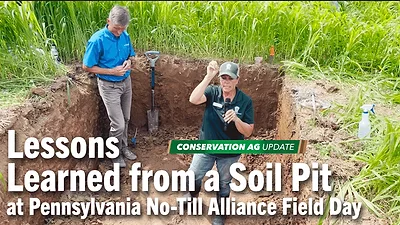Tyler Troiola is using smart spray technology on his 2,800-acre corn, soybean and wheat operation near Eagle, Wis., for the first time, continuing a family tradition of innovation that dates back to the inaugural National No-Tillage Conference in 1993.
“My uncles attended the very first National No-Tillage Conference, so our family has been no-tilling for over 30 years now and cover cropping for at least 15 years,” Troiola says. “They’ve always been on the cutting edge of farming.”
30 years later, Troiola followed in his uncles’ footsteps by attending the 2023 National No-Tillage Conference in Indianapolis, Ind., which sparked his interest in smart spray technology.
“There were a couple presentations and discussions about smart sprayers,” Troiola says. “I was skeptical at first but became interested after hearing other no-tillers talk about the cost savings. Plus, I want to be an early adopter of this technology before chemical usage is regulated because there are already counties in Wisconsin where atrazine use is restricted. I figured, why not try to cut down on herbicide usage on my own before it’s regulated?”
Retrofit First. After talking it over with his agronomist, input supplier and friends, Troiola decided to give John Deere See & Spray a try for the 2024 growing season. He went the retrofit route for his 2018 John Deere R4038 sprayer, opting for the See & Spray Premium. It’s a $25,000 system that can be installed on John Deere sprayers equipped with ExactApply nozzle systems as old as model year 2018.
“Being in no-till, we don’t have to buy a lot of new equipment, so that frees up a lot of our budget to spend on technology,” says Troiola, who also uses RTK, GPS and Deere’s AutoPath guidance. “It makes the most sense for our sprayer to be the most technologically advanced piece of equipment because we use it more frequently than anything else on our farm.”
See & Spray Ultimate comes factory installed on new sprayers, but that was out of Troiola’s budget, even though he admits it’s probably the better system. See & Spray Premium is a 1-tank boom system that allows farmers to either target spray established weeds or broadcast spray entire fields, whereas Ultimate is a dual-tank system that can simultaneously target spray and broadcast spray during the same pass.
“We turned off See & Spray Premium and used the sprayer for a normal broadcast application for our first pass,” Troiola says. “With no-till and cover crops, we’re already a 2-pass system anyways. We burn down our cover crops before we plant into them, and then we come back in June around V5 and spray again. Now, we’re just going to move some of our residuals from the second pass to the first pass to try to keep the weeds down. And then the second pass will be with See & Spray.”
Will it Work? Troiola traded in his Hagie sprayer for a used 2018 John Deere R4038 sprayer with a 120-foot boom and 1,000 gallon-tank so he could upgrade to See & Spray Premium. His dealer, Sloan Implement, installed the 36-camera system, which took almost 2 weeks to complete.
“Deere told them it would take up to 80 hours to install,” Troiola says. “They laughed and said, ‘No way.’ But Deere was right. It ended up taking about 2 solid weeks to install the system because it’s the first one they’ve done. I’m sure the second system they install will be a lot faster. It’s a big learning curve for them, just like it is for me.”
Troiola anticipates some road bumps, just like with any other new technology. He believes timing will be important because the bigger the corn and soybeans, the more they’re going to shade out weeds and potentially block the cameras from seeing them. On the flipside, if he sprays too soon, he worries the weeds might be too small to detect.
“The other thing I’m questioning in a no-till situation with a lot of cereal rye is how the cameras are going to handle heavy residue,” Troiola says.
He predicts he’ll have to add an extra sprayer pass this season to work out the kinks. There’s also a question about label rates.
“A lot of these products don’t have a label rate for See & Spray,” Troiola says. “We need to work through that. My thought is if you’re only spraying 10-20% of the field, then you can afford to do a higher tank mix rate on that acreage. We’ll obviously still follow the labels, but we’re hoping to be on the higher end of the rates.”
Despite all the unknowns, Troiola is optimistic the technology is practical for no-till with cover crops. He has extra time to scout and add another pass if needed, and his weed bank isn’t very big to begin with, thanks to his cereal rye.
“I’m hoping the chemical savings will ultimately pay for the cost of the technology,” Troiola says. “If I can save dollars on chemicals every year, I should be able to apply that to the technology, instead of investing in a bunch of chemicals. It will require some patience, but I’m excited about it. I think it’s the future.”
Troiola says the dealership will help calibrate the system before he uses it for the first time when making his second sprayer pass in June. Find out how his maiden See & Spray voyage goes in part 2 of this feature coming soon.
Related Content
You Invested in a Smart Spraying System, Now What?
Customer Checklist: 8 Things to Consider When Buying a Smart Sprayer
John Deere's See & Spray Premium Available on 2025 Hagie STS Sprayers







